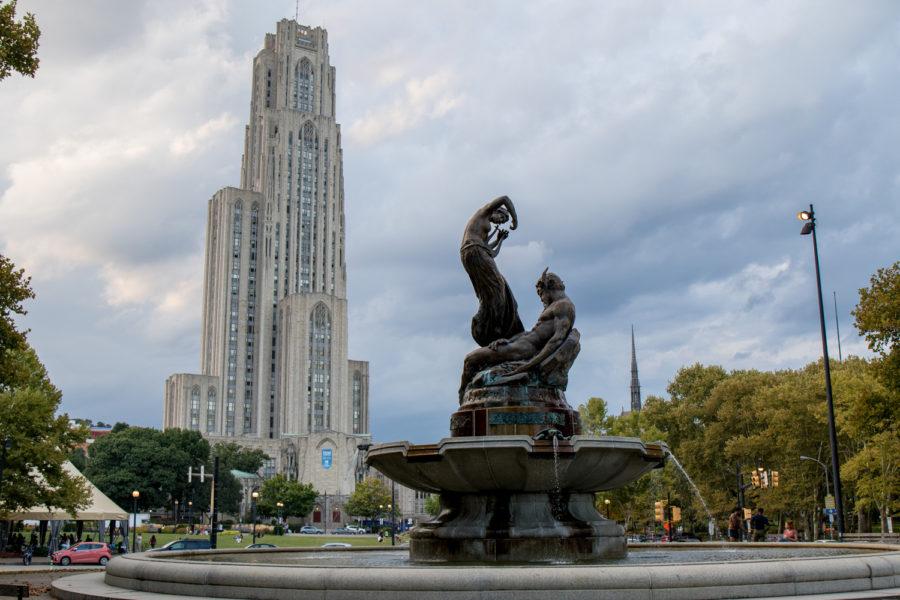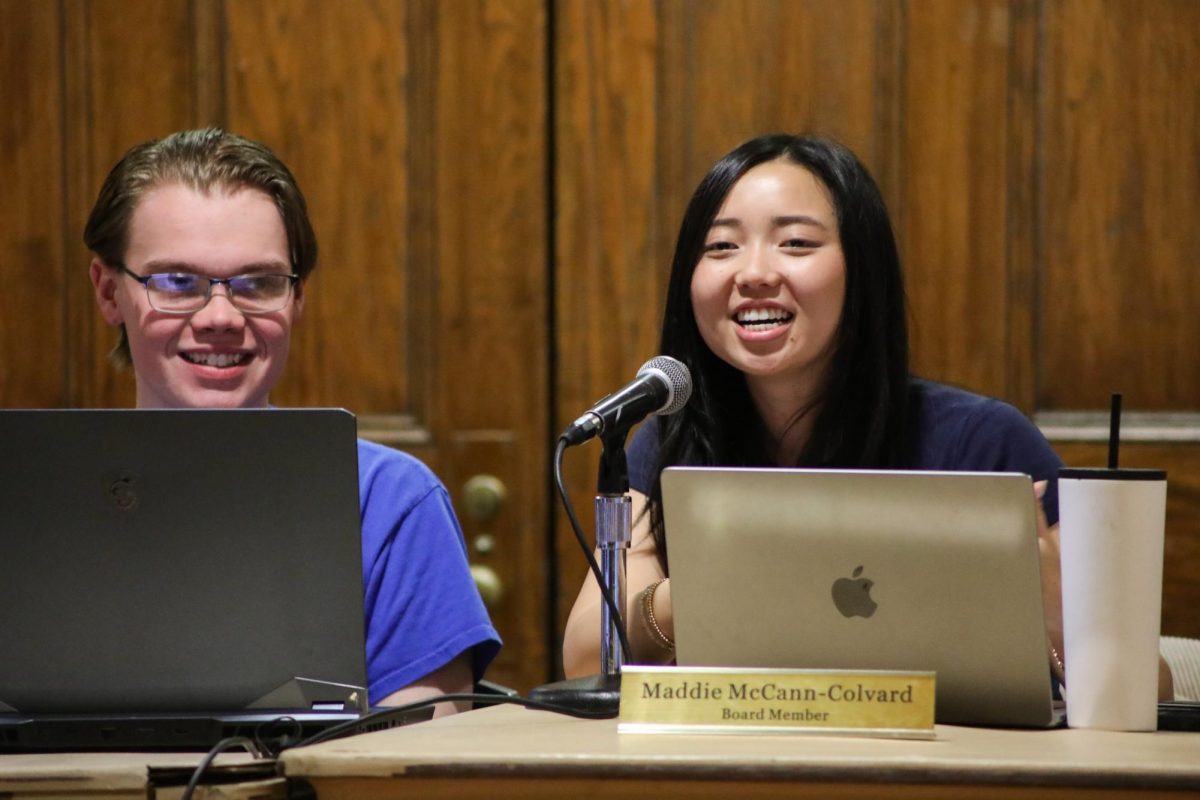‘Anxiety-inducing experience’: Students adjust to shelter-in-place guidelines, criticize lack of University enforcement
Thomas Yang | Senior Staff Photographer
Pitt enacted a shelter-in-place period last Thursday — three days earlier than previously scheduled — after a ‘significant’ increase in COVID-19 cases following Halloween weekend.
November 20, 2020
For Bailey Hedges, a first-year studio arts major, Pitt’s shelter in place has barely changed her daily routine. She said she’s avoided public spaces the whole semester and only leaves her dorm room to get food and study for finals at Hillman Library.
“For the most part the shelter-in-place guidelines have not changed my day-to-day routine drastically because I have refrained from social gatherings throughout the semester,” Hedges said. “But now I do limit the time I spend in public spaces, and I am only going to on-campus dining halls to avoid non-University students.”
Pitt enacted this shelter-in-place period last Thursday — three days earlier than previously scheduled — after a “significant” increase in COVID-19 cases following Halloween weekend. Pitt also moved to the Elevated risk posture last Thursday, the middle level of its three-tiered reopening system.
During the shelter in place, students are allowed to leave their rooms or apartments to attend classes, labs or clinicals in person, pick up food, study in the library, go to work and shop “for essentials and medical needs.”
Other students like Melina Hudson, a junior environmental engineering major, said the shelter-in-place guidelines have changed her behavior somewhat. Hudson said while the move from the Guarded to Elevated risk posture didn’t change her class locations, it did limit her social interaction.
“I don’t go outside my house that often, especially with finals week coming up, I have pretty much been studying all day,” Hudson said. “But during the semester I would meet up with people while being socially distanced, however when the shelter-in-place protocol took effect I cut that out of my routine.”
Hudson said while she followed the University COVID-19 mitigation protocols, she was disappointed in some students’ behavior over Halloween weekend that elicited the early shelter in place. She said she felt as though they were not being considerate of others.
“I think that the fact that off-campus parties are still happening is pretty disappointing, and I think that is sad that people are putting their desire to party over the health and safety of the public,” Hudson said. “I was disappointed when we went back to Elevated risk, because I knew that we had the potential to stay in Guarded risk, but with the shelter in place being enforced only a week or so later it made sense.”
Hudson said while Pitt has been somewhat successful at enforcing guidelines on campus, she wishes they would do more off campus. Harris said she attributes a lot of the rise in cases to off-campus partying.
“I think Pitt has been moderately effective at enforcing the guidelines, because I have heard of cases where students have been asked to leave residence halls,” Hudson said. “But I haven’t seen any evidence of students who have been partying off campus being disciplined.”
Hudson added that she hopes all students follow the guidelines for the sake of their families.
“I agree with the shelter-in-place protocols, and I think it necessary for us to follow them so we don’t spread the risk of COVID to our family members and people in our hometowns,” Hudson said.
Savanna Lattanzi, a senior political science and sociology double major, said while she has closely followed the shelter-in-place guidelines, it hasn’t always been easy on her mental health.
“Sheltering in place has been somewhat of an anxiety-inducing experience, just because we aren’t going outside and getting an adequate amount of social interaction which can make everyone feel very isolated and lonely,” Lattanzi said.
She also said there is a lack of communication between off-campus students and the University about how they should effectively shelter in place, especially because there’s little enforcement of the guidelines off campus. Lattanzi lives off campus in North Oakland.
“I think the shelter-in-place protocols make sense if you are living on campus, however these protocols aren’t as feasible for those living off campus because a lot of off-campus students work jobs to afford their housing,” Lattanzi said. “And there is no true effective enforcement that I have witnessed from the University for off campus students.”
Lattanzi added that she notices more people not following guidelines such as wearing masks and avoiding large social gatherings off campus because of this lack of enforcement.
“I’ll see a bunch of people on a Friday night heading to South Oakland without masks, and I think we will continue to see that because there is still that mentality that we are young so we won’t die from COVID, and many people still don’t understand the risks,” Lattanzi said.
Pitt spokesperson Pat McMahon said that Pitt police do ask students to wear face coverings, but don’t issue fines for non-compliance. Pitt has taken a student-led approach through SGB and University collaborative programs to implement strategies to ensure campus safety, rather than heavy enforcement by Pitt police.
Hedges said while she hasn’t seen much enforcement of COVID-19 guidelines from Pitt officials, she has noticed positive peer pressure to encourage safety.
“Based on what I have seen I do think that students are following the protocols, and I have even witnessed that when students don’t follow the rules other students are quick to correct them and make sure everyone is staying safe,” Hedges said. “I have personally told people who weren’t following the rules to keep the safety of other people in mind, and even if you don’t want to be safe for yourself do it for others who may be more at risk.”
In addition to more enforcement mechanisms, some students also wish there were more easily accessible COVID-19 tests on campus, especially before students leave for winter break. Hedges said she would feel safer moving out of her residence hall and going home if she knew she didn’t have COVID.
“I think tests would be extremely helpful to the move out process and would make me feel a lot more safe going home with the knowledge that I wasn’t bringing the virus back to my hometown,” Hedges said.
Students do have access to an at-home COVID-19 test after they go home for Thanksgiving break. Pitt partnered with testing company Quest Diagnostics to offer one optional, self-collected COVID-19 test to all students, if ordered between last Monday and Nov. 30.
Lattanzi said she thinks it’s irresponsible that Pitt didn’t provide free COVID-19 tests throughout the semester. Lattanzi said she’s been tested for COVID-19 multiple times during the semester, including through Pitt’s surveillance testing program and through off-campus facilities.
“It is really frustrating that Pitt does not offer free COVID tests, because it makes it even more inaccessible to students who have to pay $80 just to make sure they are not putting others at risk,” Lattanzi said. “I think this is negligent on the University’s part by not providing accessible testing.”
Hedges said she’s hopeful that there will be a return to normalcy soon if students follow COVID-19 mitigation guidelines.
“We all just have to work together and do what we are told, because I am sure everyone wants things to go back to normal,” Hedges said. “And following the rules is the only way to get there.”



